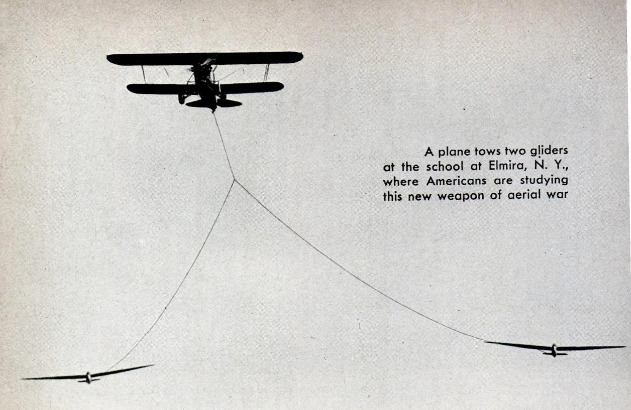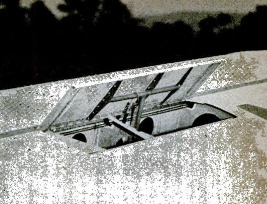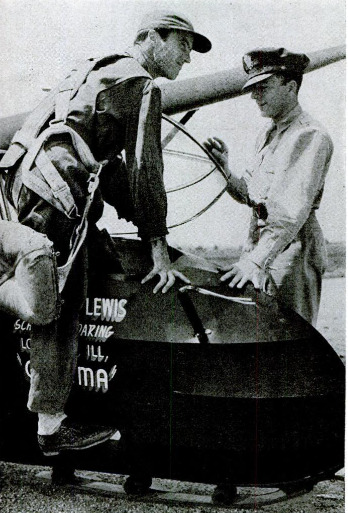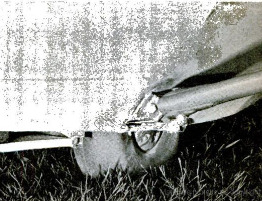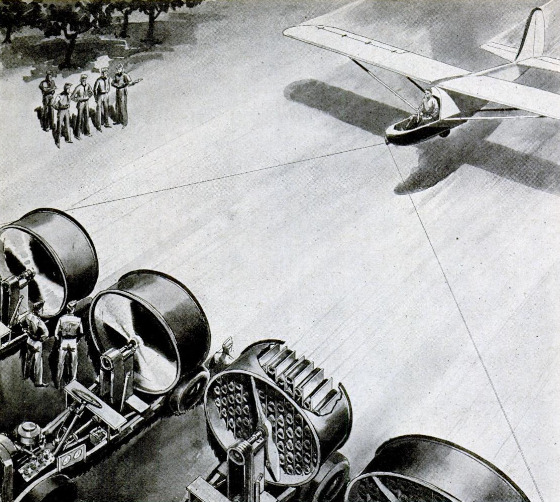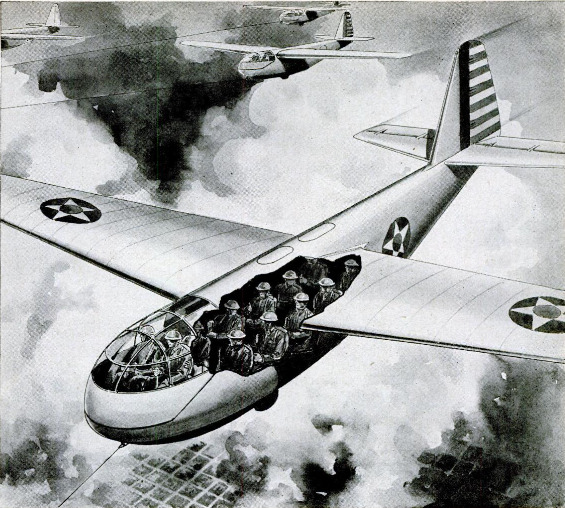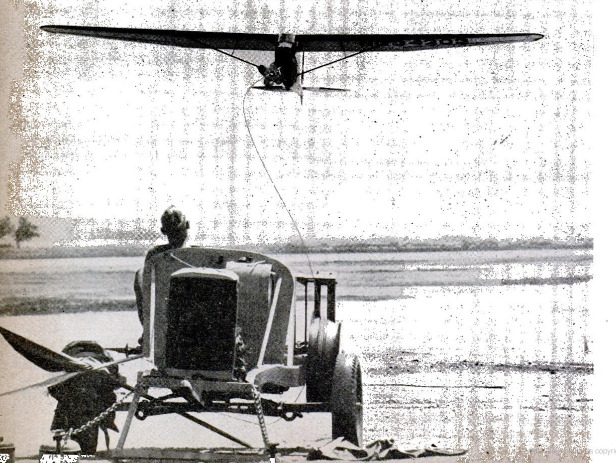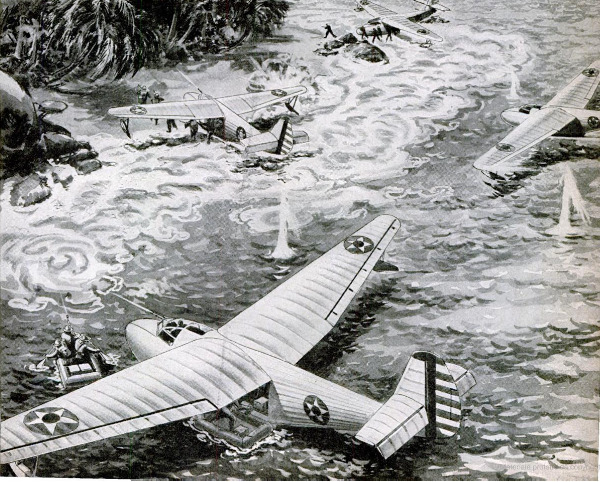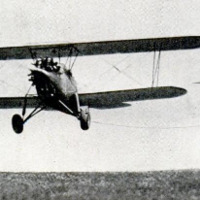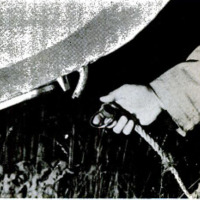-
Title (Dublin Core)
-
Fighter pilots try new wings
-
Article Title and/or Image Caption (Dublin Core)
-
Title: Fighter pilots try new wings
-
extracted text (Extract Text)
-
AIRMEN of America's fighting forces are
learning to use a new kind of wings.
Convinced by demonstrations on European
battlefields that motorless aircraft can't be
overlooked as military weapons, useful for
invasion or other purposes, both the Army
and the Navy are now experimenting with
gliders.
Recent orders assigning Army men to this
work were unprecedented. as heretofore the
Air Corps has looked with disdain on motor-
less fiying for its pilots. Air Corps officers
have been assigned as observers at soaring
contests of The Soaring Society of America,
at Elmira, N.Y., to be sure, and individu#
officers have attended soaring meets out of
purely personal interest. But the official
Air Corps attitude has been distinctly cold
toward the use of gliders for any purposes.
The Navy's entry into this field, isn't so
radical a turn-about in attitude as that of the
Army, for in 1934-1935 it did officially carry out
experiments with motorless craft at Pensacola.
However, those experiments were restricted to
an investigation of the value of training of student
pilots and had nothing to do with the employment
of gliders as an invasion vehicle.
At present, the Navy is working on two designs
for troop or cargo-carrying gliders, according
to recent testimony given the House Naval
Affairs Committee by Commander Ralph S.
Barnaby, the Navy's expert on motorless
flying and president of the Soaring Society
of America. One of these would be capable
of water landings. This is most logical inas-
much as the Navy's Marine Corps has long.
Deen a specialist in the art of landing troops
under fire.
Design and piloting of troop - carrying
gliders, which the Army is also working on,
present no special problems, either. Such
matters are governed mainly by the power
and stalling speed of the tow plane. The
latter is important because the gliders con-
stitute quite a drag and the tow plane must
be flown as slowly as the aerodynamic char-
acteristics of the gliders require. Any air-
plane pilot can fly motorless craft after a
few hours spent becoming familiar with the
“feel” of the glider and its behavior charac-
teristics, which is the usual procedure in
making the transition from one type or
weight of airplane to another.
The first Army Air Corps order provided
that six pilots take a course spread over
three weeks at the Warren E. Eaton Motor-
less Flight Facility at Elmira, N.Y, and
that another six do the same at the Frank-
fort-Lewls School of Soaring, at Lockport,
TIL. These courses call for a minimum of
25 hours of soaring and 10 hours of piloting
towed gliders. Both schools opened for
civilian motorless-flight training this spring.
The first phase consists of tows at a few
feet altitude, the towing being supplied by
automobile or winch, to become familiar
with the craft. Utility gliders of the Frank-
lin type are used in the early phases because
they are rugged enough to stand up under
practice landings and take-offs, efficient
enough aerodynamically to permit fairly
extensive soaring. The pilots graduated to
sailplanes in the later phases. Particularly
useful in learning to master sailplanes are
the two-place, metal-structure Schweizers
‘manufactured in Elmira. About 22 hours of
motorless flying was called for with land-
ings by tow car or winch. The balance of
the 30 hours was to be spent in single and
multiple tows behind powered planes. Alto-
gether they put in 10 to 14 hours per day on
both ground and flight work.
It should be remembered in all discussions
of motorless flying that there are two types
—gliding, which is merely sliding downhill
in the air after the craft has been cut loose
from tow-car, winch or airplane, and soar-
ing, which means gaining altitude by means
of vertical currents.
All utilities can soar. Even the heaviest
powered airplanes are boosted upward on
occasion. For most efficient soaring (or
airsailing) we have the sailplane with its
high aspect ration wing. The military would
be primarily interested, of course, in gliders
that can glide long distances after they have
been cut loose. The gliding ratio of a glider
is about 14 feet in the horizontal plane to
one vertically, while sailplanes have a
gliding ratio of about 20 to one.
The Army pilots experienced no trouble in
making the transition from the high-pow-
ered, heavy Air Corps planes to which they
were accustomed to the motorless craft.
They readily won the Federation Aeronau-
tique International “C License,” which is
the international license (issued in this
country through the Soaring Society acting
for the National Aeronautic Association) in
recognition of achievement of a basic soar-
ing flight. To qualify a pilot must fly his
ship above the point of release for at least
five minutes before official observers.
On one solo flight Major Frederick R.
Dent, assistant chief of the Materiel Divi-
sion at Wright Field, and in charge of the
research project at Elmira, climbed from
point of release at 1500 feet to 4,000 feet
above the valley of the Chemung River fac-
ing the Eaton soaring site at Elmira. That
he at least among the Army men had been
impressed by the potentialities of soaring
as an advanced training procedure is evi-
denced by his statement that “Any power
pilot can increase his proficiency by glider
flying.”
The seriousness with which the Army is
taking this research program is indicated
by Major Dent's regular position at Wright
Field. The other pilots were detached from
duty at the Middletown, Pa., and Fairfield,
Ohio, Air Corps depots, and other posts.
A multiple-tow take-off is done as fol-
lows: The tow plane is stationed as far
down the runway as is necessary to spread
the motorless craft behind it. They are
placed on the ground in the same position
they will occupy in the air. The formation
may be tandem, one ship behind the other
with a rope lining each unit, or fanned out,
with an individual rope between each unit
and the tow plane. The length of the rope
between the plane and the first glider in
the usual V formation of three gliders is
300 to 500 feet. A wire or & %-inch stranded
rope is used.
On signal the airplane pilot moves the
throttle ahead gradually. As each glider
gains flying speed, which of course they
reach before the airplane gets up flying
speed, it takes off and then is held close to
the ground until the airplane is in the air.
From then on the gliders keep slightly above
the tow plane and in regular step formation,
the pilots being careful not to vary much
from this position lest the drag be seriously
increased or the plane made unmanageable
Dy exerting downward, sideward, or upward
pulls. Each glider pilot can release from
the tow plane as desired and the tow-plane
pilot can cut loose from his charges behind.
Usually there is an automatic release in
case an excessive pull is exerted. A Waco
and a Stearman served as the “aerial tugs”
at Elmira.
There has been much talk about the great
reservoir of glider pilots possessed by Ger-
many, and the idea that we should have a
similar pilot backlog. It is a fact that some-
thing like 100,000 motorless-flight pilots
were trained there but they were glider-
trained simply because under the Versailles
Treaty Germany was allowed or could af
ford only the motorless types of craft.
We in this country have a much better
backlog. With something like 100,000 civil-
ian airplane pilots (including students) we
have a group that could become excellent
glider pilots through only short transition
periods. And new pilots can be brought
along faster than was ever possible in Ger-
many through glider flying alone, because
learning to handle the controls of an air-
craft, which is the primary phase of flight
instruction, can be learned quicker and more
positively on our thousands of powered civil
aircraft. This country's great fleet of light-
planes thus constitutes one of our greatest
assets, militarily as well as in a civil sense.
We also have a corps of experienced soar-
ing pilots for instruction and supervision
purposes. The 144 glider pilots certified by
the CAA as of June 1 seems to constitute
a small group. But of that number 58 held
commercial certificates, which means that
they are authorized to give instruction, and
many others of the 144 could be given fur-
ther training to qualify. In addition there
are several hundred persons who have had
much experience in all phases of motorless
flight over many years who are available
to assure plenty of competent leaders to put
whatever program might be selected on a
sound basis.
Where the Army and Navy will go from
here is anybody's guess at the moment. Both
services have emphasized strongly that their
present work is highly experimental. Per-
haps, however, by the time this appears at
least a substantially expanded research pro-
gram will have been launched, or possibly
the services will have plunged into the de-
velopment of fully organized glider transport
corps. In any case, the soaring movement
stands ready to do its part, and without
doubt one of the most radical innovations
in our military history is in the making.
-
Language (Dublin Core)
-
Eng
-
Date Issued (Dublin Core)
-
1941-09
-
pages (Bibliographic Ontology)
-
60-65
-
Rights (Dublin Core)
-
Public domain
-
Archived by (Dublin Core)
-
Sami Akbiyik
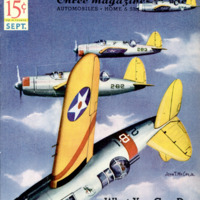 Popular Science Monthly, v. 139, n. 3, 1941
Popular Science Monthly, v. 139, n. 3, 1941

